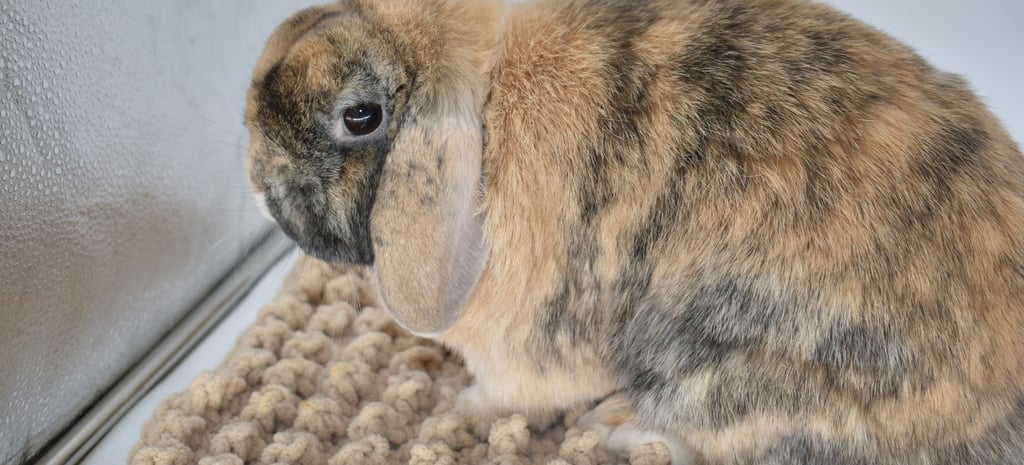Liver Lobe Torsion in Rabbits
Liver Lobe Torsion is a frightening health crisis for all rabbits. Learn the symptoms and treatment of this often silent killer.
Amy J.
7/3/20255 min read


We were recently notified by Robyn, a long time HCB client and friend, that one of her Buns (Hamish) was diagnosed with Liver Lobe Torsion (LLT) and needed emergency surgery to save his life. Let's learn a bit about LLT, so we can all be well-informed and responsible pet owners.
Robyn's four year-old neutered buck, Hamish, had always been a very healthy, happy little guy. He has been getting to know another one of her Buns, Sweet Pea, as a bonding friend.
This is what Robyn communicated via email:
"He (Hamish) stopped eating mid-day Friday, wouldn’t eat Saturday morning. I put him in Sweet Pea’s cage when I went down at 6 AM to try to get him moving around but he just stayed like a lump in the corner. Sweet Pea was very disappointed that he wasn’t interested in her attention.
I called my vet when they opened at 8:30 but they had no openings. I called the new emergency vet (nearby) and got a 10:30 appointment. The vet there examined him, did blood work. She discovered that some level having to do with his liver, which shouldn’t be over 100 was 500. She did an ultrasound on his liver (which led to the diagnosis). She did surgery yesterday afternoon and said he did great. She called me this morning and said he was clear-eyed and had a little sass. He is on fluids, syringe feeding and pain meds. Once he is pooping normally, I can bring him home. I am very encouraged by everything she has told me. The vet said this issue is not uncommon with Holland Lops. She said she does this type of surgery a few times a month. Do you find that to be true? I liked the vet (she even has a bun of her own)."
Hamish has had a very happy ending and is now fully recovered, but how did all of this happen?
What is Liver Lobe Torsion (LLT)?
Liver lobe torsion is a serious medical condition that can affect humans, dogs, cats, rats, pigs, horses, and rabbits, including the popular lop-eared breeds. It occurs when one (or even two) of the five sections of the rabbit’s liver, known as lobes, twists around its blood supply, cutting off circulation. The lack of circulating blood leads to tissue death (necrosis) and internal pain and distress. Without prompt veterinary intervention, liver lobe torsion can be fatal.
Why does the condition seem to be more prevalent in Holland Lops and other lop-ear rabbit breeds?
Lop-eared rabbits (American Fuzzy Lop, English Lop, French Lop, Mini Lop, and Holland Lop) appear to be more prone to liver lobe torsion than other breeds. While the exact cause is not yet fully understood, their anatomy may play a role. Lop rabbits often have a more compact body shape with a deeper chest cavity, which could contribute to the liver being more mobile within the abdomen. This increased mobility (and lack of additional ligaments to hold it in place) may make it easier for the liver to become twisted. Some researchers suspect a genetic component could predispose some rabbits to Liver Lobe Torsion, but scientific studies are needed to prove or disprove this theory.
What causes Liver Lobe Torsion to develop?
The causes of liver lobe torsion are largely unknown. In some cases, it seems to occur spontaneously, without a clear cause. However, increased activity, such as jumping, playing, or even self-grooming, may contribute to the twisting of a liver lobe. Digestive issues, trauma, or anatomical abnormalities can also increase the risk. Because LLT is an internal condition, it often goes unnoticed until the rabbit exhibits severe symptoms of pain and discomfort.
What are the symptoms of Liver Lobe Torsion?
Recognizing the signs of liver lobe torsion is vital for rabbit owners. Early symptoms may include lethargy, a lack of appetite, and a reduction in fecal output. Rabbits may sit in a hunched over manner, grinding their teeth in pain, or avoid movement. As the condition progresses, they may exhibit signs of shock including rapid breathing and pale gums. These symptoms all point to a medical emergency that requires immediate veterinary attention. Because of the similarity of these symptoms to those of GI Stasis, testing at your rabbit-savvy veterinarian's office is necessary.
How does a rabbit-knowledgeable Veterinarian Diagnose Liver Lobe Torsion?
To diagnose liver lobe torsion, a rabbit-savvy veterinarian will perform a physical examination, followed by recommended bloodwork. Blood chemistry is very useful in determining the proper diagnosis of LLT, as there will be marked increases in alanine aminotransferase (ALT), alkaline phosphatase (ALKP), and aspartate aminotransferase (AST). Imaging, such as an abdominal ultrasound, will point to a definitive diagnosis. An accurate diagnosis is essential because the only effective treatment is surgery to remove the twisted lobe.
How is Liver Lobe Torsion treated?
Depending upon the length of time since the rabbit began exhibiting symptoms and the severity of the rabbit's pain, surgery to remove the affected lobe is usually the only treatment option available to save the rabbit's life. This surgery, called a hepatectomy, involves removing the affected lobe very carefully, leaving the rest of the organ undamaged and able to regenerate a new lobe to replace the one that was removed.
If caught extremely early, before the rabbit is stressed, showing signs of anemia, or extreme pain, there are some less invasive treatment options that can be tried, but they tend to work for very few rabbits, and the majority need to have the surgery anyhow. At that point it's sometimes too late for the rabbit to have a successful outcome with the surgical option.
What will happen if my rabbit doesn't have surgery?
A twisted liver lobe no longer has blood flow, which will cause the tissue to die. If the dead tissue is not removed quickly, it will leak toxins into the bloodstream. These toxins will lead to systemic infection, organ failure, and death.
How much does Liver Lobe Torsion diagnosis, treatment, and after-care cost?
LLT treatment costs are significant, averaging around $2800 in the greater Cleveland area, but costs could be higher, depending upon where you live. Diagnostics can run several hundred dollars, the surgery itself can be $1.5k, and the post-surgical care, pain medication, and follow-up care can add several hundred dollars more. It's impossible to give an exact cost estimate, but we wanted to share this information as a guideline for being prepared for life's unexpected surprises when it comes to bunny care.
Because of the high cost of treating rabbits for various ailments, we do recommend considering purchasing pet insurance to help you afford very costly emergency vet bills. Research your options carefully and ask questions when speaking to a customer service representative.
What is the long-term prognosis?
Rabbits who have been successfully treated for Liver Lobe Torsion go on to live very normal, happy lives. There is an incredibly low possibility of LLT recurring in the same rabbit.
Hamish is doing wonderfully and is back to his old self once again. We're looking forward to welcoming him and his Bun-friends Sweet Pea, Basil, and Rosie for a stay at Camp HCB later this summer!
Additional Reading:
Link to article written by a veterinarian that is a bit more technical, but contains excellent information to aid in understanding clinical findings in diagnosing Liver Lobe Torsion. https://www.mspca.org/angell_services/identification-and-management-of-liver-lobe-torsion-in-domestic-rabbits/
Link to another veterinarian's straightforward responses to questions about Liver Lobe Torsion treatment and diagnosis.
https://rabbitsavior.com/2022/12/kanfers-answers-liver-lobe-torsion/
